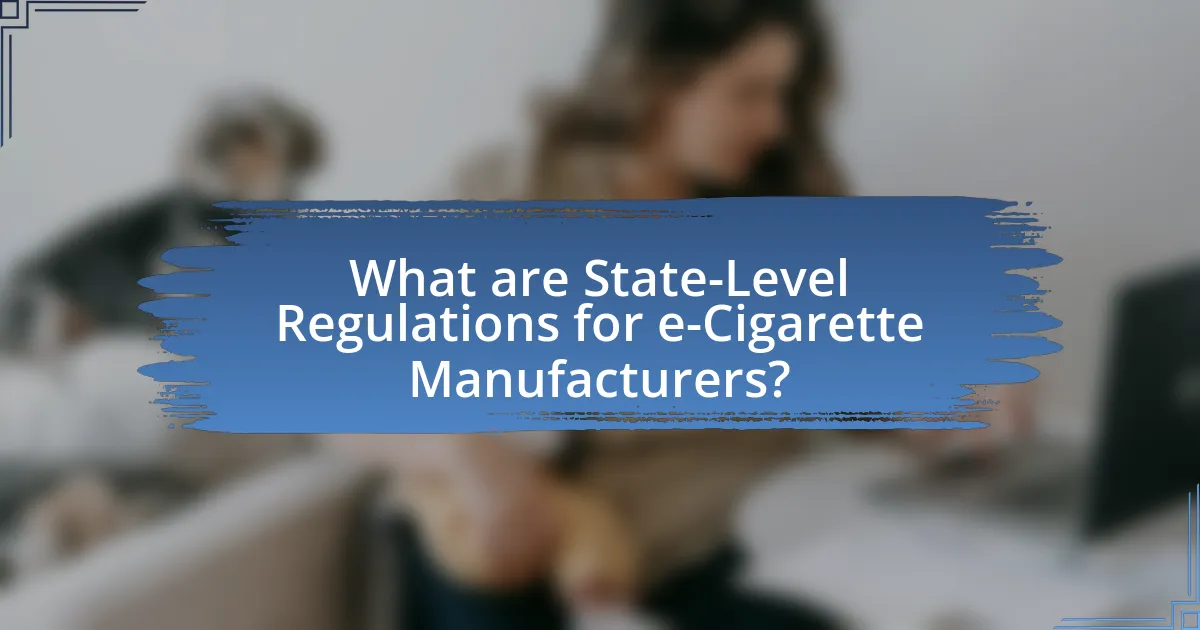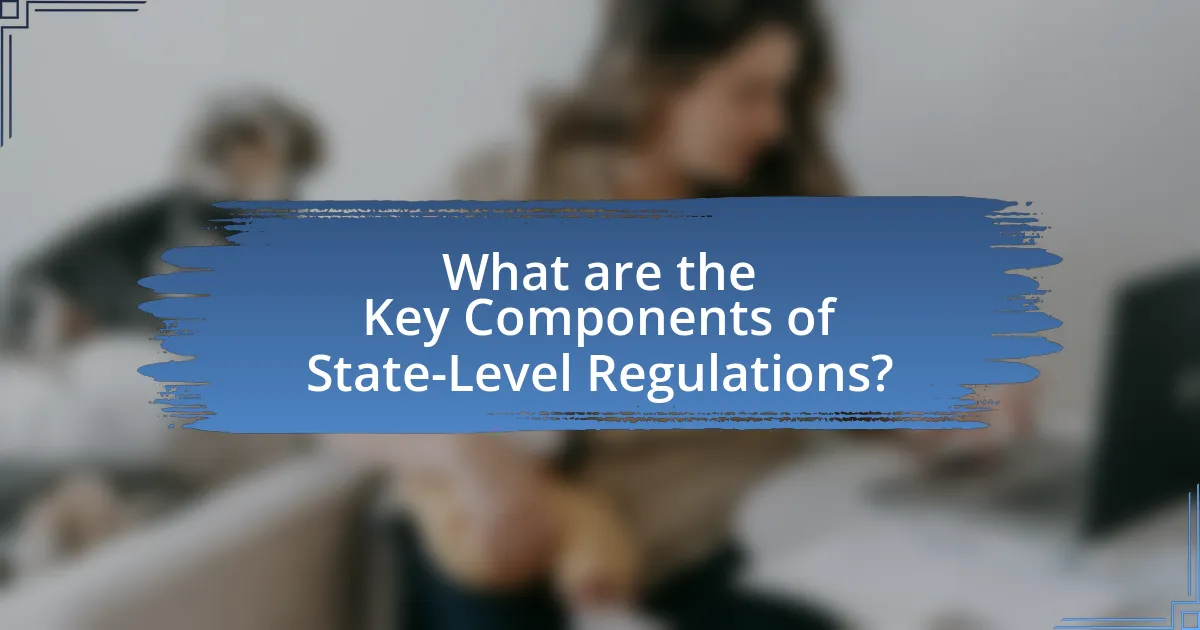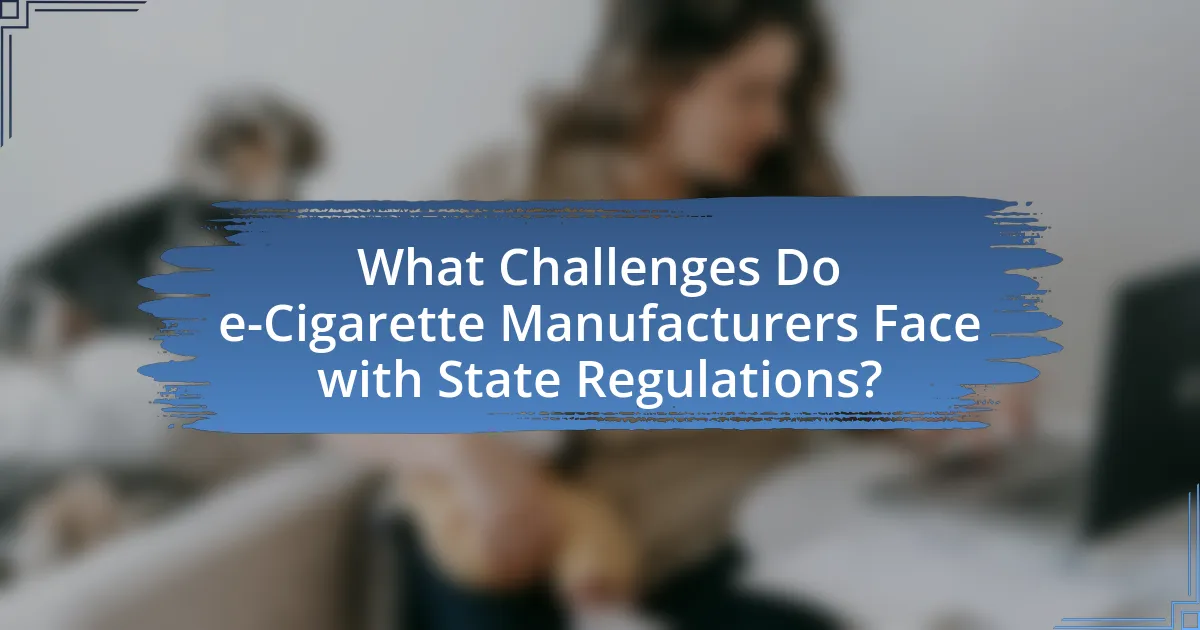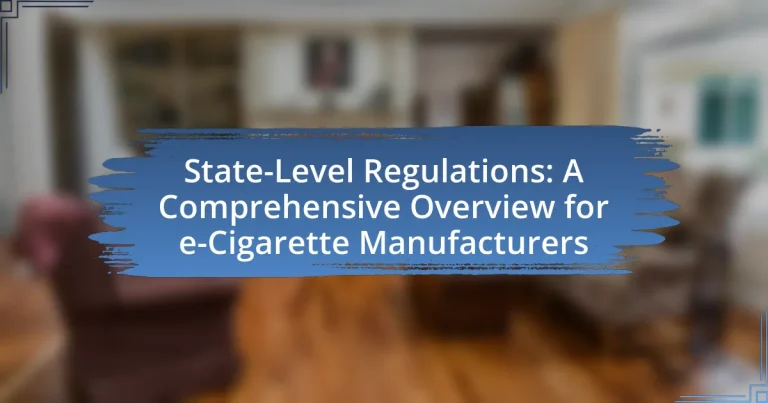State-level regulations for e-cigarette manufacturers in the United States vary widely, with each state establishing its own rules regarding production, sales, and marketing. Key components of these regulations include licensing requirements, age restrictions, labeling mandates, advertising limitations, and taxation policies, all aimed at protecting public health and ensuring consumer safety. The article explores how these regulations differ across states, the factors influencing these differences, and the implications for manufacturers, including compliance challenges and the potential consequences of non-compliance. Additionally, it highlights best practices for manufacturers to navigate the complex regulatory landscape effectively.

What are State-Level Regulations for e-Cigarette Manufacturers?
State-level regulations for e-cigarette manufacturers vary significantly across the United States, with each state implementing its own set of rules governing the production, sale, and marketing of e-cigarettes. For instance, some states require manufacturers to obtain specific licenses, adhere to age restrictions for sales, and comply with labeling requirements that include health warnings. Additionally, states like California and New York have enacted stringent regulations that impose taxes on e-cigarette products and restrict flavors to reduce youth access. These regulations are often influenced by public health initiatives aimed at reducing smoking rates and protecting minors from nicotine addiction.
How do state-level regulations differ across the United States?
State-level regulations across the United States vary significantly in terms of e-cigarette manufacturing, sales, and marketing practices. For instance, some states impose strict age verification requirements and flavor bans, while others have more lenient regulations, allowing a wider range of products and marketing strategies. According to the National Conference of State Legislatures, as of 2023, states like California and New York have enacted comprehensive regulations that include high taxes on e-cigarettes and restrictions on advertising, whereas states such as Texas and Florida have adopted less restrictive approaches, focusing primarily on age restrictions without extensive regulatory frameworks. This disparity reflects differing public health priorities and political climates across the states.
What factors contribute to these differences in regulations?
Differences in regulations for e-cigarettes across states are primarily influenced by public health priorities, political ideologies, and economic considerations. Public health priorities often dictate stricter regulations in states with higher concerns about youth vaping and health risks associated with e-cigarettes. For instance, California has implemented stringent regulations to curb youth access, reflecting a strong public health stance. Political ideologies also play a significant role; states with more liberal policies tend to favor comprehensive regulations, while conservative states may prioritize personal freedom and economic growth, resulting in looser regulations. Economic considerations, such as tax revenue from e-cigarette sales, further influence regulatory approaches, with states like New York imposing high taxes to generate revenue while controlling usage. These factors collectively shape the regulatory landscape for e-cigarettes at the state level.
How do state regulations impact e-cigarette manufacturing practices?
State regulations significantly impact e-cigarette manufacturing practices by establishing specific standards for product safety, labeling, and marketing. For instance, states like California and New York have implemented stringent regulations that require manufacturers to disclose ingredients and adhere to safety testing protocols, which directly influences production processes. Additionally, regulations may dictate the types of flavors allowed, affecting product formulation and consumer appeal. These state-level mandates ensure compliance with public health objectives and can lead to increased operational costs for manufacturers, as they must invest in quality control and regulatory compliance measures.
Why are state-level regulations important for e-Cigarette manufacturers?
State-level regulations are important for e-Cigarette manufacturers because they establish specific legal frameworks that govern the production, distribution, and marketing of e-cigarette products. These regulations can vary significantly from state to state, impacting compliance costs, product formulations, and marketing strategies. For instance, states may impose age restrictions, labeling requirements, and taxes on e-cigarettes, which directly affect how manufacturers operate within those jurisdictions. Additionally, adherence to state regulations helps manufacturers avoid legal penalties and fosters consumer trust by ensuring product safety and quality standards are met.
What risks do manufacturers face without compliance?
Manufacturers face significant risks without compliance, including legal penalties, financial losses, and reputational damage. Non-compliance with state-level regulations can lead to fines that may reach thousands of dollars, as evidenced by the enforcement actions taken against companies violating e-cigarette laws. Additionally, manufacturers may experience increased scrutiny from regulatory bodies, resulting in potential shutdowns or product recalls, which can further exacerbate financial instability. Furthermore, failure to adhere to compliance standards can erode consumer trust, leading to a decline in sales and market share, as consumers increasingly prefer brands that demonstrate regulatory adherence and commitment to safety.
How do regulations protect consumers and public health?
Regulations protect consumers and public health by establishing standards for product safety, quality, and marketing practices. These regulations ensure that e-cigarette products are tested for harmful substances, thereby reducing the risk of exposure to toxic chemicals. For instance, the Family Smoking Prevention and Tobacco Control Act empowers the FDA to regulate tobacco products, including e-cigarettes, which helps prevent misleading advertising and ensures that health warnings are clearly communicated. Additionally, regulations often mandate age restrictions on sales, which protects minors from accessing potentially harmful products. This framework of oversight is crucial in promoting informed consumer choices and safeguarding public health.

What are the Key Components of State-Level Regulations?
The key components of state-level regulations include licensing requirements, age restrictions, product labeling, advertising restrictions, and taxation policies. Licensing requirements ensure that manufacturers and retailers comply with state laws, while age restrictions typically mandate that e-cigarette products can only be sold to individuals over a certain age, often 21. Product labeling regulations require clear information on ingredients and health warnings, ensuring consumer safety. Advertising restrictions limit how and where e-cigarette products can be marketed, often prohibiting ads that target minors. Taxation policies impose specific taxes on e-cigarette sales, which can influence pricing and consumption patterns. These components collectively aim to regulate the e-cigarette industry, protect public health, and ensure compliance with state laws.
What types of regulations exist for e-Cigarette manufacturers?
E-cigarette manufacturers are subject to various regulations that include federal, state, and local laws. At the federal level, the Food and Drug Administration (FDA) regulates e-cigarettes as tobacco products under the Family Smoking Prevention and Tobacco Control Act, which mandates premarket review, labeling requirements, and restrictions on marketing to minors. State regulations can vary significantly and may include age restrictions for purchase, taxation on e-cigarette products, and specific packaging and labeling requirements. For instance, some states have implemented flavor bans to reduce youth access to e-cigarettes. Local regulations may further restrict where e-cigarettes can be sold and used, reflecting community standards and public health goals.
How do licensing and registration requirements vary by state?
Licensing and registration requirements for e-cigarette manufacturers vary significantly by state, with some states requiring specific licenses for manufacturing, distribution, and retail, while others may have minimal or no requirements. For instance, California mandates a manufacturer’s license and a seller’s permit, while states like Texas require a general business license but have fewer specific regulations for e-cigarettes. Additionally, states such as New York impose strict regulations, including health department approvals and extensive reporting requirements, contrasting with states like Florida, which have more lenient rules. This variation is influenced by each state’s approach to public health, taxation, and tobacco control policies, leading to a complex regulatory landscape for e-cigarette manufacturers operating across multiple states.
What are the labeling and packaging requirements imposed by states?
States impose various labeling and packaging requirements on e-cigarette products to ensure consumer safety and compliance with local laws. These requirements typically include clear identification of the product, health warnings, and ingredient disclosures. For instance, many states mandate that e-cigarette packaging must display a warning that the product contains nicotine, which is addictive, and may include additional health warnings about the risks of using tobacco products. Furthermore, some states require child-resistant packaging to prevent accidental ingestion by minors. Compliance with these regulations is essential for manufacturers to avoid penalties and ensure their products are legally marketable within each state.
How do taxation policies affect e-Cigarette manufacturers?
Taxation policies significantly impact e-Cigarette manufacturers by influencing their pricing strategies and profit margins. Higher taxes on e-Cigarettes can lead to increased retail prices, which may reduce consumer demand and subsequently affect sales volumes. For instance, a study by the American Journal of Public Health found that a 10% increase in e-Cigarette taxes could result in a 5% decrease in consumption. Additionally, manufacturers may face increased operational costs due to compliance with tax regulations, which can further strain their financial resources. Thus, taxation policies play a crucial role in shaping the economic landscape for e-Cigarette manufacturers.
What are the different tax structures applied to e-cigarettes?
E-cigarettes are subject to various tax structures that differ by state, including excise taxes, sales taxes, and specific e-cigarette taxes. Excise taxes are often levied based on the quantity or price of the product, with some states imposing a percentage of the retail price, while others apply a fixed amount per milliliter of liquid. For example, as of 2023, California imposes a 65% excise tax on the retail price of e-cigarettes, while New York has a tax of $0.20 per milliliter of e-liquid. Additionally, some states have enacted specific taxes targeting e-cigarettes, separate from traditional tobacco taxes, to address public health concerns. These tax structures aim to regulate consumption and generate revenue, reflecting the growing market for e-cigarettes and the need for state-level oversight.
How do taxes influence pricing and consumer behavior?
Taxes significantly influence pricing and consumer behavior by increasing the cost of goods, which can lead to reduced demand. When taxes are imposed on e-cigarettes, manufacturers often pass these costs onto consumers through higher prices. For instance, a study by the American Journal of Public Health found that a 10% increase in e-cigarette prices due to taxes can result in a 20% decrease in consumption among young adults. This price sensitivity indicates that higher taxes can deter consumers, particularly price-sensitive groups, from purchasing e-cigarettes, thereby impacting overall market dynamics and consumption patterns.

What Challenges Do e-Cigarette Manufacturers Face with State Regulations?
e-Cigarette manufacturers face significant challenges with state regulations, primarily due to the variability and complexity of laws across different states. Each state has its own set of rules regarding the sale, marketing, and taxation of e-cigarettes, which can lead to compliance difficulties. For instance, some states impose strict age verification processes and advertising restrictions, while others may have specific flavor bans or packaging requirements. This inconsistency can create confusion and increase operational costs for manufacturers, as they must adapt their products and marketing strategies to meet diverse legal standards. Additionally, the rapid evolution of regulations can lead to uncertainty, making it difficult for manufacturers to plan long-term business strategies.
How can manufacturers navigate the complexities of state regulations?
Manufacturers can navigate the complexities of state regulations by implementing a robust compliance strategy that includes thorough research, consultation with legal experts, and continuous monitoring of regulatory changes. This approach ensures that manufacturers stay informed about the specific requirements in each state, such as licensing, labeling, and product safety standards. For instance, the National Association of Attorneys General reported that over 40 states have enacted specific regulations for e-cigarettes, highlighting the need for manufacturers to adapt to varying legal landscapes. By leveraging resources such as state regulatory agencies and industry associations, manufacturers can effectively manage compliance risks and align their operations with state laws.
What resources are available for understanding state-specific regulations?
State-specific regulations can be understood through various resources, including government websites, legal databases, and industry associations. Government websites, such as state health department pages, provide official guidelines and updates on regulations. Legal databases like Westlaw and LexisNexis offer comprehensive access to state laws and case law relevant to e-cigarette manufacturing. Additionally, industry associations, such as the Vapor Technology Association, provide resources, advocacy, and insights into regulatory changes affecting e-cigarette manufacturers at the state level. These resources collectively ensure that manufacturers stay informed about compliance requirements and regulatory developments.
How can manufacturers ensure compliance across multiple states?
Manufacturers can ensure compliance across multiple states by implementing a robust regulatory framework that includes thorough research of each state’s specific laws and regulations. This involves regularly updating their compliance protocols to reflect changes in state legislation, engaging legal experts familiar with state laws, and utilizing compliance management software to track requirements. For instance, the National Association of Attorneys General provides resources that outline state-specific regulations, which can aid manufacturers in maintaining adherence to diverse legal standards.
What are the potential consequences of non-compliance?
The potential consequences of non-compliance with state-level regulations for e-cigarette manufacturers include legal penalties, financial losses, and reputational damage. Legal penalties can manifest as fines or sanctions imposed by regulatory bodies, which can vary significantly by state; for instance, California has strict penalties for violations of its tobacco control laws. Financial losses may arise from the inability to sell products that do not meet regulatory standards, leading to decreased revenue. Additionally, reputational damage can occur as consumers may lose trust in brands that do not adhere to regulations, impacting long-term business viability. These consequences underscore the importance of compliance for e-cigarette manufacturers operating within regulated markets.
What legal actions can be taken against non-compliant manufacturers?
Legal actions that can be taken against non-compliant manufacturers include fines, product recalls, and suspension or revocation of licenses. Regulatory agencies, such as the Food and Drug Administration (FDA) in the United States, enforce compliance through inspections and can impose penalties for violations of state-level regulations. For instance, manufacturers found in violation of the Family Smoking Prevention and Tobacco Control Act may face fines up to $10,000 per violation. Additionally, states may initiate lawsuits to seek damages or injunctions against manufacturers that fail to adhere to local laws governing e-cigarette products.
How can non-compliance affect a manufacturer’s reputation and business operations?
Non-compliance can severely damage a manufacturer’s reputation and disrupt business operations. When manufacturers fail to adhere to state-level regulations, they risk facing legal penalties, which can include fines and sanctions. For instance, a study by the National Association of Attorneys General found that companies violating regulations can incur fines that significantly impact their financial stability. Additionally, non-compliance can lead to negative media coverage, eroding consumer trust and brand loyalty. According to a survey by the Reputation Institute, 70% of consumers are less likely to purchase from brands that have faced regulatory issues. This loss of consumer confidence can result in decreased sales and market share, ultimately jeopardizing the manufacturer’s long-term viability.
What best practices should e-Cigarette manufacturers follow to comply with state regulations?
e-Cigarette manufacturers should implement rigorous quality control measures, ensure accurate labeling, and maintain compliance with age restrictions to adhere to state regulations. Quality control involves regular testing of products for harmful substances, which is mandated by various state laws to ensure consumer safety. Accurate labeling must include all ingredients and nicotine content, as required by regulations in states like California and New York, to inform consumers and prevent misleading claims. Additionally, manufacturers must enforce strict age verification processes to prevent sales to minors, aligning with laws in states such as Texas and Florida that impose penalties for non-compliance. These practices collectively help manufacturers meet legal requirements and promote public health.
How can manufacturers stay updated on changing regulations?
Manufacturers can stay updated on changing regulations by actively monitoring government websites and industry associations that publish regulatory updates. Regularly reviewing resources such as the FDA’s website, state health department announcements, and trade organizations like the Vapor Technology Association provides timely information on legislative changes. Additionally, subscribing to newsletters and alerts from regulatory bodies ensures that manufacturers receive immediate notifications about new regulations affecting e-cigarette products. Engaging with legal experts who specialize in regulatory compliance can further enhance understanding and adaptation to evolving laws.
What strategies can be implemented to ensure ongoing compliance?
To ensure ongoing compliance with state-level regulations for e-cigarette manufacturers, implementing a robust compliance management system is essential. This system should include regular training for employees on current regulations, continuous monitoring of regulatory changes, and the establishment of clear internal policies and procedures that align with state laws. For instance, a study by the National Association of Attorneys General highlights that companies with dedicated compliance teams are 30% more likely to adhere to evolving regulations. Additionally, conducting periodic audits and assessments can identify potential compliance gaps, allowing for timely corrective actions.


